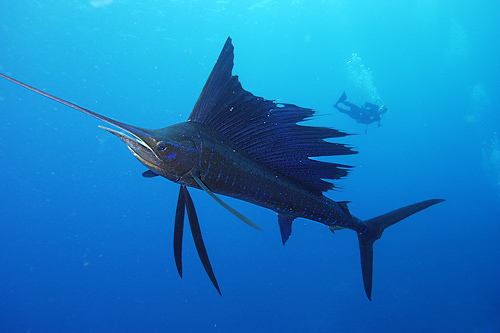
Indo-Pacific Sailfish
The Atlantic bluefin tuna (Thunnus thynnus) is a majestic and powerful fish, renowned for its size, speed, and commercial value. This highly migratory species plays a crucial role in the marine ecosystem. It's a top predator of high economic importance.
10 13 years
Lifespan
340 cm
Length
Least Concern
Conservation Status
110 km/h
Swimming speed
Carnivorous
Diet
Highly Migratory, Pelagic Migration
Migration
Appearance Overview
The Atlantic bluefin tuna is renowned for its large, streamlined body, built for speed and endurance in the ocean.
Coloration
Dark metallic blue above, silvery white below
Fins
Two dorsal fins, the second taller than the first; short pectoral fins
Body shape
Torpedo-shaped, allowing for efficient swimming
Length
Up to 13 feet (4 meters)
Weight
Up to 2,000 lbs (907 kg)
Diet
Carnivorous, feeding on a variety of fish, squid, eels, and crustaceans.
Feeding Behavior
Aggressive predator that hunts by sight and uses its speed to capture prey. They often hunt cooperatively, herding and trapping smaller fish.
Social Behavior
Highly migratory, forming large schools, especially during spawning season. Schools can be mixed with other tuna species.
Commercial Relevance
Extremely high value, especially in sushi and sashimi markets, where a single fish can fetch hundreds of thousands of dollars.
Conservation measures
Subject to international fishing quotas, stock management plans, and monitoring programs. Efforts include tagging and tracking to study migration patterns.
Status
Endangered (Varies by specific stock; some are overfished)
Threats
Overfishing (historically and continuing), bycatch in fishing gear, habitat degradation, and climate change affecting prey distribution.
Habitat Distribution
Depth Range
0-1,000 meters (typically in the upper layers, but can dive deep)
Geographic Range
Western and Eastern Atlantic Ocean, including the Mediterranean Sea
Preferred Environment
Temperate and subtropical waters; pelagic (open ocean)
Reproduction and Life Cycle
Breeding Habits
Spawns in warm waters, with two main spawning grounds: the Mediterranean Sea and the Gulf of Mexico. Spawning occurs in spring and summer.
Development Stages
Eggs hatch into larvae, which develop rapidly. Juveniles grow quickly, reaching significant size within the first year. Growth continues throughout their life.
Fecundity
Highly fecund; a single female can release up to 30 million eggs per spawning season.
Maturity Age
Matures at around 4-8 years in the Mediterranean and 8-12 years in the Gulf of Mexico.
Faqs about Indo-Pacific Sailfish
Where are Atlantic bluefin tuna found?
Atlantic bluefin tuna are found in the Atlantic Ocean, from Newfoundland to the Gulf of Mexico in the west, and from Norway to the Mediterranean Sea in the east.
Do Atlantic bluefin tuna migrate?
Yes, they are highly migratory, undertaking long journeys across the Atlantic for feeding and spawning.
How long do Atlantic bluefin tuna live?
They can live up to 40 years, although this is rare due to fishing pressure.
What do bluefin tuna eat?
They primarily eat smaller fish (like herring and mackerel), squid, and crustaceans.
What is the biggest threat to bluefin tuna?
The main threat is overfishing, driven by high demand in the seafood market.
Are bluefin tuna warm-blooded?
They are warm-blooded, which allows them to maintain a higher body temperature than the surrounding water, aiding in muscle efficiency.
Can Atlantic Bluefin Tuna swim fast?
Yes, due to their size, speed, and warm-blooded nature, they can swim very fast, up to 43 mph (70 km/h) in short bursts.
Copyright @ Nature Style Limited. All Rights Reserved.
 English
English